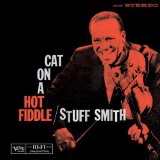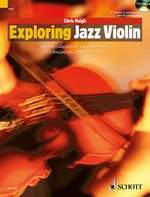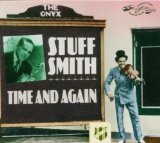
MENU TO FIDDLE STYLES:
Stuff Smith (1909-67)
Alongside Grappelli and Venuti, Stuff Smith was undoubtedly one of the three great swing violinists of the early 20th century. He was an African-American, born Hezekiah Leroy Smith, in Ohio; his nickname came from his habit of referring to other people whose name he couldn't remember as "Stuff".His first notable work was with the Alphonso Trent Orchestra in the 1920's; at the time it was not uncommon for dance bands to have a violionist who could contribute occasional swing solos.It was not until 1936 that he got his major break; he formed a band with his lifelong friend, trumpeter Jonah Jones and as a sextet they took a residency at New York's Onyx club,where their driving rhythm, exciting performance and good humour made them a hit with audiences and critics.
Two of their most successful recordings of the time were "I'se a Muggin" and "You'se a Viper".Smith's comedy vocals were an important part of the formula, as was his eccentric habit of wearing on stage a top hat and either a stuffed monkey or parrot on his shoulder. However, this comic presentation belies the quality of his playing, which was virtuosic and technically adventurous.
Though not considered a bebop violinist, he definitely had leanings in that direction; trumpeter Dizzie Gillespie was a great admirer of Smith, and credits him with many of the harmonic innovations which pointed him towards bebop. Stuff Smith jammed with the likes of Charlie Parker, something which I'm sure would have daunted Venuti or Grappelli.
Stuff Smith's violin technique
His hero was Louis Armstrong, and there is a strong horn-like element to his playing. expressed both in frequent explosive stabs and pauses between phrases. He frequently uses double stops, parallel fifths and octaves; one of his trademark licks is an electrifying series of chromatically ascending octaves; he raised the roof when he unleashed this one at the "Violin Summit" in 1966, alongside Grappelli, Ponty and Asmussen.
His phrases often start with a single long, fierce note, and he frequently alternates short arco and pizzicato sections. His aggressive, slightly scratchy tone is not mellowed by his wide vibrato, and he is not afraid to use deliberate dissonance and riffs which step outside the chords. His playing is always technically ambitious, but his sense of humour is clear, with quotes for The Irish Washerwoman or Coming Through the Rye appearing unexpectedly.
Here's a terrific, typically explosive performance filmed in Denmark in 1965, playing Bugle Call Blues. Notice his frequent use of octaves, including some sliding up the neck, and his interjection of open string pizzicatto between phrases. You also hear the downward series of trills or rolls which is one of his trademarks.
Stuff Smith and the Electric violin
Stuff Smith is credited as being the pioneer of the electric violin. Although we today take amplification of the violin for granted, in the days of the swing bands it was a serious problem for a violinist to be heard on a noisy bandstand. In the 20's, with the Alphonso Trent Orchestra he used a Stroh fiddle, with a horn like on an old fashioned gramophone. He experimented unsuccessfully with a pickup and homemade amplifier "as big as a room!", and then whilst at the Onyx Club was presented with a purpose-built National Dobro Vio-Lectric. He took to it like a duck to water, saying “oh, oh, this is it, man!”; he appeared in endorsement adverts and used it extensively.
After two years in New York, he went to Hollywood to appear in the film Swing Street; this was the end of his Onyx Club run, but he continued to find work with a variety of line-ups, including recording sessions with Dizzie Gillespie, Oscar Peterson, Nat Cole, Ella Fitzgerald and even Sun Ra.
He appeared with Stephane Grappelli on “Violins No End”, and more than held his own at the 1966 Violin Summit alongside Grappelli, Svend Asmussen and Jean-Luc Ponty. He also produced several fine solo albums. He never achieved the commercial success of Stephane Grappelli, not least because his harsh and aggressive tone was never as appealing to audiences, but he is almost universally admired among jazz violinists for the drive, intensity and invention of his playing.
He was still playing up to his death in Munich in 1967.
_____________________________________________________________________________
RETURN TO CHRIS HAIGH'S JAZZ VIOLIN PAGE
RETURN TO JAZZ VIOLIN LESSONS PAGE
RETURN TO FIDDLING AROUND THE WORLD HOMEPAGE
What Stuff Smith lacks in tone and finesse he more than makes up for with melodic and rhythmic invention, and the sheer force of his playing. This collection gives you an excellent overview of his playing at the peak of his career.
Disk one covers the period 1935-39, and is mostly with his Onyx Club Boys line-up. The majority are vocal numbers, with Smith displaying his “Jive Talkin’” humour that you might be more familiar with from the likes of Louis Jordan. I’s a Muggin is one such number, a big hit for Stuff which was covered by Grappelli and Reinhardt, among others. The solos tend to be short, but some, such as Old Joe’s hittin the Jug, are exceptional; the “outsidedness” of his playing shows him as a player well ahead of his time. The fireworks really start on disk 2, which is mostly instrumental numbers recorded with his trio (with piano and bass) between 1940 and 45. The bebop influence on his playing is clear in numbers such as The Red Jumps, and his playing is full of excitement and danger, peppered throughout with parallel fifths and strident octave licks. We get no less than three versions of Desert Sands, a Smith composition which became something of a theme tune, almost certainly influenced by the Duke Ellington hit Caravan. With 49 tracks, and a 15-page booklet this is terrific value. If you buy nothing else by Stuff Smith, this is the one to get.




